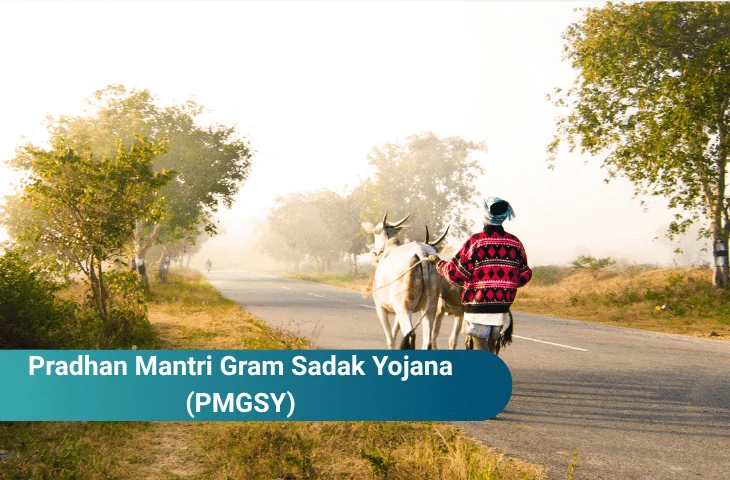Pradhan Mantri Gram Sadak Yojana (PMGSY) is a flagship program of the Government of India aimed at providing all-weather road connectivity to rural habitations. The scheme was launched on 25th December 2000, PMGSY plays a crucial role in enhancing socio-economic development in rural India by connecting remote villages to markets, healthcare facilities, educational institutions, and other essential services.
The program is implemented by the Ministry of Rural Development, with state governments acting as key partners. The National Rural Infrastructure Development Agency (NRIDA) oversees the program at the national level, ensuring that projects are executed with quality and efficiency.
Why was PMGSY Launched?
The primary reason for launching PMGSY was to bridge the urban-rural divide and improve rural livelihoods. Prior to PMGSY, rural roads were often neglected due to insufficient funding and lack of proper planning. The scheme was designed as a poverty alleviation strategy, as good connectivity improves farm-to-market access, creates employment opportunities, and promotes overall socio-economic growth.
What are the Objectives of PMGSY?
PMGSY is designed to achieve several interrelated objectives:
- Rural Connectivity
- Poverty Reduction
- Upgradation of Roads
- Quality and Sustainability
- Employment Generation
Target Areas of PMGSY
The target area under the PMGSY focuses on population thresholds and geographical factors:
- Plain Areas: Habitations with a population of 500 or more (based on Census 2011).
- Special Category Areas: North-Eastern States, Hill States (Himachal Pradesh, Uttarakhand), Desert Areas, and selected backward districts with 250 or more people.
- Left-Wing Extremism (LWE) Areas: Habitations with 100 or more people.
Check Out: Complete List of Important Schemes for NABARD Grade A Exam
How is PMGSY Implemented?
PMGSY projects are implemented through a decentralized and structured approach, ensuring local participation and technical oversight:
- Executing Agencies: State governments or UT administrations designate agencies responsible for executing the projects.
- Programme Implementation Units (PIUs): At the district level, PIUs coordinate and supervise the implementation.
- Linkages with DRDAs: PIUs work closely with District Rural Development Agencies for fund disbursement and monitoring.
- Quality Control: A three-tier quality control system ensures high standards:
- Field-level checks by project engineers
- Independent State Quality Monitors
- National Quality Monitors from NRIDA
- Monitoring via Digital Tools: The Online Management, Monitoring, and Accounting System (OMMAS) tracks the progress of projects in real-time.
What are the Different Phases of PMGSY?
Since its inception, PMGSY has been implemented in multiple phases to address evolving rural connectivity needs:
| Phase | Period | Key Features |
| Phase I | 2000 – 2013 | – Targeted 1,35,436 habitations with all-weather connectivity – Upgraded 3.68 lakh km of rural roads, including 40% of state-funded renewal – Fully centrally funded |
| Phase II | 2013 – 2022 | – Focused on upgrading existing rural roads for improved village connectivity – Cost-sharing between Centre and States: 75:25, and 90:10 in hill, desert, and LWE-affected regions – Targeted 50,000 km of road construction under the 12th Five-Year Plan |
| Phase III | 2019 – 2025 | – Consolidated Through Routes and Major Rural Links, connecting habitations to GrAMs, hospitals, and higher secondary schools – Funds shared 60:40 between Centre and States; 90:10 for North-Eastern and Himalayan states – Focused on socio-economic development by enhancing accessibility and infrastructure |
| Phase IV | 2024 – 2029 | – Approved on 11th September 2024, aims to connect 25,000 unconnected habitations- Road length: 62,500 km, total outlay ₹70,125 crore – Incorporates modern technologies like Cold Mix Technology – Maintains three-tier quality monitoring system and focuses on all-weather road construction |
Get ready to crack government job exams with leading educators
What are the Key Features of PMGSY?
The key features of PMGSY:
- Centrally Sponsored Scheme: Funding varies as per region.
- 60:40 ratio for most states
- 90:10 for North-Eastern and Himalayan states
- Quality Control: Three-tier system ensures project durability and compliance with standards.
- Green Technologies: Promotes eco-friendly construction using local materials and waste.
- Digital Monitoring: Real-time tracking through OMMAS.
- Local Participation: Panchayati Raj institutions and elected representatives play a key role in identifying habitations for connectivity.
Why is PMGSY Important for Rural India?
PMGSY is a transformative scheme with far-reaching socio-economic benefits:
- Economic Growth
- Employment Generation
- Education & Healthcare Access
- Inclusive Development
- Infrastructure Development
What are the Challenges Faced while Implementing PMGSY?
Despite its success, PMGSY faces several challenges:
- Funding Limitations: Road construction and maintenance require continuous funding, which may strain government budgets.
- Harsh Terrains: Construction in hilly, desert, and flood-prone areas is technically challenging.
- Material and Labor Costs: Prices of construction materials and skilled labor fluctuate, affecting project timelines.
- Weather Conditions: Extreme rainfall, snowfall, and heat can delay construction and reduce road longevity.
- Planning & Management Issues: Inefficient planning may lead to resource wastage, project delays, and increased costs.
How does PMGSY Promote Sustainable and Green Development?
PMGSY emphasizes eco-friendly road construction through:
- Use of local and non-conventional materials, including industrial and municipal waste.
- Adoption of cold mix technology, which reduces energy consumption.
- Promoting durable roads that require less frequent maintenance, saving resources in the long term.
Also Check: List of Government Schemes of India
How does PMGSY Enhance Employment Opportunities?
Road construction under PMGSY generates employment for:
- Skilled workers: Engineers, technicians, and project managers.
- Unskilled labor: Local youth and women engaged in manual work.
- Indirect employment: Transport services, local vendors, and ancillary industries benefit from improved connectivity.
What has been the Impact of PMGSY So Far?
Since its launch, PMGSY has achieved remarkable results:
- Road Construction: Over 6.8 lakh km of roads built as of December 2021.
- Connectivity: Thousands of previously unconnected habitations now have all-weather access.
- Socio-Economic Development: Improved farm-to-market connectivity, access to healthcare and education, and enhanced livelihood opportunities.
- Employment: Millions of jobs created in construction and related sectors.
Key Takeaways
| Aspect | Key Points |
| Launch Year | 2000 |
| Objective | Provide all-weather road connectivity to rural habitations |
| Implementing Agency | Ministry of Rural Development, NRIDA |
| Funding Pattern | 60:40 for most states, 90:10 for NE & Himalayan states |
| Phases | Phase I, II, III, IV (current) |
| Road Construction Target | 62,500 km under PMGSY-IV |
| Population Criteria | 500+ in plains, 250+ in NE/Hill/Special Areas, 100+ in LWE zones |
| Technology | Cold Mix Technology, eco-friendly construction |
| Quality Control | Three-tier system: Field, State, National |
| Benefits | Economic growth, employment, improved healthcare & education access, inclusive development |
| Challenges | Funding, harsh terrain, weather, material & labor costs, planning issues |
Questions Based on Pradhan Mantri Gram Sadak Yojana
- When was PMGSY launched?
a) 1998
b) 2000
c) 2002
d) 2005
e) 2010 - Which ministry implements PMGSY?
a) Ministry of Finance
b) Ministry of Rural Development
c) Ministry of Home Affairs
d) Ministry of Agriculture
e) Ministry of Transport - What is the population criteria for PMGSY in plain areas?
a) 100+
b) 250+
c) 500+
d) 1000+
e) 1500+ - Which agency oversees PMGSY at the national level?
a) NHAI
b) NRIDA
c) DRDA
d) CEA
e) NITI Aayog - Which phase of PMGSY aims to connect habitations to GrAMs and hospitals?
a) Phase I
b) Phase II
c) Phase III
d) Phase IV
e) Phase V - How is PMGSY-IV funded?
a) Fully central government
b) 50:50 Centre-State
c) 60:40 for most states, 90:10 for NE & Himalayan states
d) 75:25
e) 100% state government - Which technology is emphasized for eco-friendly road construction under PMGSY?
a) Hot Mix Technology
b) Cold Mix Technology
c) Asphalt Concrete
d) Cement Concrete
e) Bituminous Macadam - Which of the following is a key challenge for PMGSY?
a) Funding limitations
b) Too many roads
c) Excess connectivity
d) High literacy
e) Urban overdevelopment - How many kilometers of road are targeted under PMGSY-IV?
a) 25,000 km
b) 50,000 km
c) 62,500 km
d) 70,000 km
e) 1,00,000 km - What is the role of Panchayati Raj institutions in PMGSY?
a) Road construction
b) Funding allocation
c) Selecting eligible habitations
d) Monitoring quality
e) Technology implementation
Also Read:
Answer Key:
| Question No. | Correct Answer |
| 1 | b) 2000 |
| 2 | b) Ministry of Rural Development |
| 3 | c) 500+ |
| 4 | b) NRIDA |
| 5 | c) Phase III |
| 6 | c) 60:40 for most states, 90:10 for NE & Himalayan states |
| 7 | b) Cold Mix Technology |
| 8 | a) Funding limitations |
| 9 | c) 62,500 km |
| 10 | c) Selecting eligible habitations |
- MISHTI Scheme, India’s Initiative to Restore Mangrove Ecosystems
- National Green Hydrogen Mission Features, Objectives, and Benefits
- Paramparagat Krishi Vikas Yojana, Transforming India’s Organic Farming
- Mission on Integrated Development of Horticulture NHM and HMNEH
- Swachh Bharat Mission, India’s Journey Towards Cleanliness and Hygiene
- SAGY, A Step Towards Holistic Development of Indian Villages

Hi, I’m Aditi. I work as a Content Writer at Oliveboard, where I have been simplifying exam-related content for the past 4 years. I create clear and easy-to-understand guides for JAIIB, CAIIB, and UGC exams. My work includes breaking down notifications, admit cards, and exam updates, as well as preparing study plans and subject-wise strategies.
My goal is to support working professionals in managing their exam preparation alongside a full-time job and to help them achieve career growth.
